Swarovski EL Binoculars with Swarovision - What are they like? Are they worth it?
MenuDecember 2011
The Swarovski EL binocular with Swarovision
which we tested was a best in class as this article is being
written. It met or exceeded expectations in all areas. Let us tell you about one of our initial
field excursions with it!
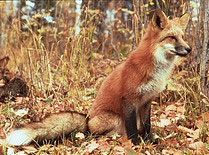
Photo by Superior National Forest
At about dusk one day, a couple of OpticsReviewer.com team members took a pair of recently purchased Swarovski binoculars, one of them the Swarovision Swarovski EL 10X42, and headed into a nearby woods to get acquainted with them. Moving quietly and pausing often to see what interesting animal activity might be observable, they didn't get far before stopping to study the sloping ground perhaps 100 ft/30m in front of them. Nestled in among the brown autumn leaves of the forest floor was patch of red color. Never having seen a sleeping fox in the wild before, it took them a couple minutes to realize that was what they were looking at. Silently watching the serenely unaware and unmoving red fox for several minutes, they began to wonder if it was alive. They then started making noises to see if it would make any movement. It showed no recognition of their presence. As the shadows deepened, they decided to see how close they could get to the ball of fur.
They started quietly moving a step or two and then pausing to check the object of their attention for signs of life. As they were moving about 15 ft/4.5m closer, a black-edged ear pushed up from the middle of the fur — obviously intently monitoring sounds from their direction. They waited.
Then, while moving perhaps an additional 3 ft/1.0m closer as quietly as they could, the fox suddenly stood up and stared at them - the light-colored fur on the lower sides of its face brightly lighting up the otherwise darkened woods in the view of their Swarovski binoculars. After moments of looking intently at their now motionless forms, the fox turned and ran silently from them, stopping only to glance back at them before vanishing in the undergrowth. Would they have been able to see the motionless fox with other binoculars that were not quite as bright, had as much contrast, or showed as much color fidelity or detail? Perhaps, but their years of experience in tramping about forests and fields made them think otherwise. They think they shared that once-in-a-lifetime experience because the excellent Swarovski optics allowed them to see the fox before they were close enough to alarm it.
The Swarovski EL binoculars with Swarovision have been available in North America since January 2010 and within perhaps six months they were being widely spoken of as providing the best binocular optics available. Since they've been reviewed by users as well as optical sites since their first appearance it's reasonable to ask "Why is OpticsReviewer.com providing another review and why don't they stick to more affordable binoculars?" The reason is two-fold: 1) it's important to have a point of reference for excellence, and 2) affordability is often a matter of priorities.
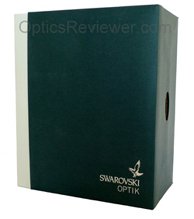
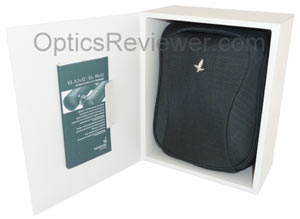
We feel a responsibility to you to provide intelligent, objective information about optics you may be considering. No matter who we (you and us) are or what we're dealing with, if we are not familiar with what excellence is in our field of endeavor, we really have no foundation for critiquing something in our field and saying whether it is good or not. So you'll know what's possible in binocular optics, we provide this Swarovski binoculars review.
Your present circumstances may seem to preclude ownership of Swarovski binoculars and it's possible that other instruments may be able to fill your needs adequately for now. When you're value shopping and making comparisons, how will you know what's an excellent value if you're unfamiliar with what constitutes excellence? Further, it's possible that you'll decide a Swarovski binocular is a priority for you and you'll find a way to make it happen. (If we used binoculars in our work, for example, we'd want the tools that would make us look as good as possible!)
The Swarovski EL binoculars we bought for this review are the 10X42 configuration and this Swarovski binoculars review is based on our use and tests of that instrument.
First of all, just what is Swarovision and why is it special? In a nutshell, Swarovision is a Swarovski term which encompasses a combination of field flattener lenses made with fluoride which, combined with long eye relief of 20mm and what Swarovski terms "optimized coatings." "Field flattener" lenses flatten the field of view optically so that there is no perceived pincushion distortion which is often engineered into optics to eliminate rolling ball or globe distortion experienced when panning across a scene. The use of fluoride in the manufacture of the glass used for the objective lenses in Swarovision makes them High Density (or Extra-low Dispersion, if you prefer) lenses and provides the best color fidelity presently possible - largely through reduction of chromatic aberration. (Swarovski points out that the machining process for the HD objective lenses is both sophisticated and complex and simply using fluoride glass in a binocular won't produce exceptional results if the entire optical system isn't tweaked for corresponding high performance.)
Speaking of chromatic aberration, none of us were able to induce it in common situations. Is it possible to induce chromatic aberration? We've heard some say that they were able to see color fringing on early production models of the Swarovski EL binoculars with Swarovision. We don't know whether that means that it was addressed by Swarovski before the model we tested for this review was made or we just didn't try hard enough, but all we were able to find was a faint yellow fringe above dark wires or branches against a clear, bright sky and just a touch of blue fringe below the wires/branches — when viewed at the periphery of the field of view. It's worth noting that we only detected that after using the Swarovski EL binoculars for some time and then only when studiously looking for it!
Lastly, before we start the binoculars (EL Swarovski) review, let's take a moment to recognize what the letters "WB" mean. The "W" is for a German word that means "wide angle." With European binocular makers, an apparent field of view greater than 60° is considered a wide angle optic. The "B" stands for a German word which means "twist-up eyecups" provided so the binocular is usable by those who wear eyeglasses and those who don't. All together, it would be correct to say we're talking about a Swarovski EL 10X42 W B Swarovision binocular. The "Swarovision" is added to distinguish this binocular from its predecessor, which was often simply referred to as the Swarovski EL W B.
For this review we ordered a recent production instrument so as to take advantage of any improvements or enhancements available as of the writing of this review in December 2011.
The Swarovski EL Binocular's Frame and Other Non-optical Elements
A Magnesium Frame
The Swarovski EL binoculars use a frame made of magnesium for strength and durability. Why is the material used for the binocular frame of interest?
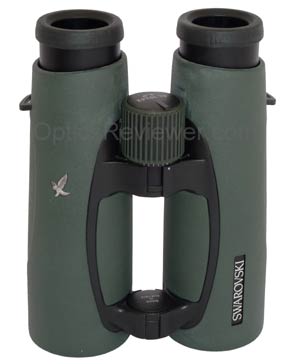
There is considerable glass used in the Swarovski EL binoculars and it's of a heavier, optical grade to ensure that your view through it will be as good as possible. The weight of the glass is unavoidable in producing excellent optics. To reduce the instrument's overall weight to an amount that people will be willing to carry and use, magnesium is used in higher-end instruments because it's even lighter than aluminum while retaining strength. Load-bearing components are made of light alloys for durability.
For all of the high-quality, optical-grade glass in the Swarovski 10X42 EL binoculars, they weigh just 29.6oz/840g as a testimony to the designers' ability to keep weight in the rest of the instrument to a minimum while maintaining quality.
This is probably a good place to mention that the "EL" in Swarovski EL binoculars stands for "Ergonomic Light." In addition to making them lightweight for extended field excursions, Swarovski endeavored to make them as ergonomically comfortable to use as possible. With binoculars, you'll take note in the field if they're unbalanced and either front- or back-heavy. The placement of the hinge and focus wheel should take into consideration the overall balance of the heavy objective lenses and the ocular's multiple, smaller lenses. If the binocular is not well-balanced, your wrists and arms will fatigue more quickly than you might wish. It's bad enough if you're stationary in a blind/hide, but if you're walking and using your binocular to see what's ahead as well as study what you've discovered, you'll find it even less enjoyable. Because the Swarovski El binoculars are well balanced, they feel lighter than they actually are and are enjoyable to use for long periods.
There are also thumb indents in the rubber armoring on the underside of the barrels. Many people say they value and appreciate these indents with the idea that they help to find the balance point quickly and easily and that's probably quite true. We find, however, that we typically position our hands based more on the focus wheel's location and less on the positioning of indents. Interestingly enough, the indents on the Swarovski EL binoculars are just about where our thumbs naturally land(!) and a seeming testimony to their ergonomic design.
The Swarovski EL Binoculars are Hermetically Sealed
As you would expect, these binoculars have been sealed with O-rings to waterproof them and then purged of air to eliminate the potential for moisture-laden molecules in air to cause internal fogging. Swarovski uses nitrogen to purge the air from inside the binocular prior to final closing.
Not only is this sealing good for keeping moisture from inside the instrument, but it will keep dust and grit from working their way inside. In this way, the quality of your view using the Swarovski EL binoculars will be as sharp and unclouded as when you first used them for as long as possible. In fact, Swarovski literature goes so far as to suggest that it's reasonable to wash dirt and dust from the instrument under running water!
What are the Eyecups Like on the Swarovski EL Binoculars with Swarovision?
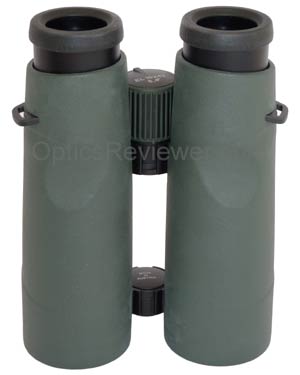
You would not expect the eyecups on optical instruments of this caliber to be ill-fitting or loose and you would not be disappointed with the Swarovski EL binoculars. The twist-up/twist-down eyecups operate with smooth precision throughout their four positions fully twisted in for eyeglass wearers, two intermediate positions, and fully extended. The first intermediate setting is about 2mm extended, the second is about 5mm more, and fully extended is about 12mm from the fully twisted in position. As noted above, with eye relief of 20mm, these binoculars are sufficiently generous with eye relief that we're pressed to imagine very many individuals needing more than what's provided.
If you're already an owner of Swarovski EL binoculars, you may have obtained the optional doubler which could be attached in place of one of the eyecups and effectively double the magnification of the binocular. The EL Swarovskis with Swarovision have larger diameter oculars and, unfortunately, the old doublers don't work with the newer Swarovision. If you value the doubler, as many do, you'll want to get a new one to use with the new, larger Swarovision oculars.
The Swarovski EL Binoculars' Focus Mechanism
The focus wheel movement of Swarovski EL binoculars is, as one would rather expect at their price point, buttery smooth and a tactile delight to adjust.
We are unembarrased advocates of a fast-focus which we define as requiring a single revolution of the focus wheel to go from close-focus to infinity. When necessary, we can adjust to a focus wheel going from close focus to infinity in 1.5 revolutions, although we sometimes feel as though we've surrendered significant ground! The reason for this is that we find that a long day of bird watching or wildlife observation and adjusting focus from near to far and back again, will tire the fingers used for adjusting the focus wheel. While it's possible to build up any muscles with exercise, there's also the matter of missing something that you needed/wanted to see because it took too long to go through the required number of turns of the focus wheel. Having said all this about fast-focus and so on, what about these binoculars?
The Swarovski EL binoculars' focus mechanism is interesting in that it's geared to require two full turns of the focus wheel to go fully from close focus to infinity, but their cleverly designed logarithmic adjustment mechanism takes it quickly from infinity to somewhere around 1.5m where the focus is much slower and precise. In fact, as we measured it, to change the Swarovski EL binoculars' focus from 20ft/6.1m to infinity took just three quarters of a revolution of the focus wheel. Are we impressed with it? Yes, you could say that. This way we have all of the fast-focus needs covered with excellent fine-focus ability for nearby objects, insects, or animals.
Where does Swarovski Make the EL binoculars? Our 10X42 configuration ELs are plainly marked as being made in Austria.
Swarovision Optical Performance
As do many compact roof prism models on the market today, the phase-corrected Swarovski EL binoculars with Swarovision use the Schmidt-Pechan prism design which allows for a shorter design length. As far as your OpticsReviewer.com team has been able to determine, the Swarobright prism coating (which is a part of Swarovision) is a dielectric or dielectric-type of prism coating introduced by Swarovski in 1999. Also a part of the Swarovision prism and lens coatings are Swarotop and Swarodur which enhance color fidelity over the color spectrum and provide scratch resistance, respectively. A more recently added lens coatings is what Swarovski elects to call Swaroclean, which is applied to the outer surface of the lens and provides a non-stick element that reduces dried-on mineral residue (water marks) from water on the lenses or other foreign materials which might settle on them. The Swarovski EL binoculars have all of these various coatings with their attendant benefits.
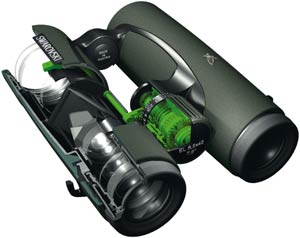
One of the significant benefits of the dielectric prism coating is that it provides a more color-neutral image. The silver prism coating, which was almost exclusively used on better binoculars requiring a prism coating (Abbe-König design prisms don't require a coating), provided a warm or slightly yellow color bias due to not fully reflecting the blue spectrum in the past. To avoid any misunderstandings, let us note here that Swarovski uses BaK-4 prisms in the EL binoculars!
Swarovski Optik has its own proprietary anti-reflective coatings, too, which almost certainly contribute to the exceptional brightness, clarity, crispness, and well-contrasted image presented to the eyes. These prism and lens coatings are generally applied in thicknesses measured in thousandths and millionths of millimeters. Knowing this, consider that an average human hair is approximately a fat and sassy seven hundredths of a millimeter thick! It gives food for thought when we consider the price of any precision optical instrument!
One of the first things a person usually notices when using Swarovski EL binoculars with Swarovision for the first time is the exceptional brightness of the image. We agree with the person who said that it's like having a close-up view of something distant, but without using binoculars because of the high resolution of detail, brightness of image, and high degree of color fidelity. For those interested in using them for astronomy, they're very clear when viewing star points and from an optical perspective we recommend them highly for star watching.
One thing that has bothered some people, at least with the early versions of Swarovision, was the "rolling ball" or "globe" effect. If it's present in an optical instrument, it will typically be more evident when panning horizontally. Some people seem to be more susceptible to it than others and it can give them nausea or headaches. For those who have said that they did notice it, a large percentage said that they became accustomed to it and didn't notice it after a period of time. Perhaps none of us are as susceptible to it as others or perhaps it had been somehow cured by the time the Swarovski 10X42 EL we used for this review was produced. Either way, we didn't notice it even though we looked hard for it. We have owned "alpha" binoculars in which we did notice it, although we were blessed by being able to ignore it at will in them. (One person said he noted the rolling ball effect in 8.5X42 Swarovski EL binoculars, but not in the 10X42 - which is interesting, but not something we can explain!)
Swarovski EL Binoculars' Liberal Field of View
We're unashamed in our love of a wide field of view. There's so much that can be either seen or missed depending on your optics field of view that we will opt for as much field of view as we can afford when given a choice. We advocate this to others, too. Think of the bird watcher who happens to catch sight of some action in the periphery of the field of view and can quickly swing the binocular to bring full attention to bear on it. Think of what you'd miss of the movement of wildlife, a spooked herd moving quickly across your field of view or a family stretched out while grazing or stalking. Think of the woodsman who wouldn't see half of what he needs and wants to see if he's limited by a narrow field of view. Finally, think of the law enforcement personnel seeking to apprehend multiple rapidly moving individuals! From our perspective, a wide field of view is almost an essential!
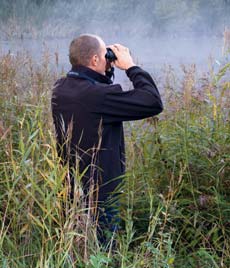
The Swarovski 10X42 EL we used and tested has a 6.4° angular field of view and provided a linear field of view of 336ft/112m at 1,000yds/m. It's the sort of thing that makes it easy to persuade others, accustomed to a narrower field of view, to our perspective when they're able to see what they've been missing.
The other Swarovski EL binoculars' configurations provide angular fields of view ranging from 5.7° to 7.6°, depending on the configuration. This results in an apparent field of view ranging from 60° to 63° and, by European optical standards, this is appropriately labeled as a wide-angle binocular.
The potential negative with many binoculars with wide angle fields of view is that producing the wide angle optics usually involves a compromise that produces a significant amount of blurring, or fuzzing, of the image elements around the periphery of the field of view. In other words, you might notice some movement in your field of view, but you'd be obliged to move the binoculars to focus their optical sweet spot, where the view is sharply focused, on the activity. Since that's a possible negative, let's talk about that next.
How Large is the Swarovski EL Binocular's Optical Sweet Spot?
It's an excellent question to ask about any binocular with a wide angle field of view. When we tested the 10X42 Swarovski EL binoculars with Swarovision (we keep mentioning the Swarovision to prevent folks thinking we're reviewing the older version of the ELs!), we measured the usable, or sharply focused, field of view and looked for optical distortion.
You may imagine our happy surprise when we found that the 99%+ of the field of view presented a very sharp, crisp image with very good contrast. The remainder of the field of view, the extreme periphery, was very, very usable and required only a very slight adjustment of the focus wheel to bring it into as sharp a focus as possible. The difference is so small that there was a discussion as to whether or not it was sufficiently significant to report to you and we decided to err on the side of full disclosure. We understand from Swarovski that this is due to the field flattener lens arrangement in Swarovision.
Color Fidelity with Swarovision in the Swarovski EL Binoculars
As we viewed our color palette and field tested the EL binoculars we found them to be color neutral and without discernable color bias in the instrument we tested. We attribute this to the dielectric prism coating (Swarobright) and Swarovski's proprietary Swarotop coatings.
Swarovision's Performance at Dusk and Dawn
In field tests with side-by-side comparisons, we found either no significant difference in light gathering and transmitting ability between the test binocular and other top-end binoculars or that it was slightly better and provided a slightly brighter view. In viewing waterfowl in early dawn's light, we found the Swarovski EL binoculars with Swarovision provided a view that was as clear and bright as some and clearer/brighter than other binoculars in its class.
Using the Swarovski EL Binoculars Under Strong Light Conditions
Are the Swarovski EL binoculars perfect? No, we think there's still room for improvement, however, like most advances we expect those improvements will come in increments. They're very good at controlling stray light, for example, and better than competitors we've tested recently. However, when we pushed them hard, we were still able to induce glare and other indicators of stray light. We mention that to warn you against having unreasonable expectations! And, yes, while we were smart enough not to look directly at the sun with them, we were foolish enough to come perilously close and we certainly don't recommend that anyone follow our example!
How Short a Distance can the Swarovski EL Binoculars Focus?
The close focus specification for the binocular we tested indicated that it could be focused on objects as close as 4.9ft/1.5m. When we measured our instrument's close focus we found it to be 4.6ft/1.4m and well within the specification given for it. We subscribe to the idea that about 8ft/2.4m is a minimum for good birding binoculars since you never know what's going to be getting close nor how close it might get before it's frightened away. The Swarovski EL binoculars fill this need nicely.
The Diopter Adjustment is Incorporated into the Focus Wheel Mechanism
To adjust the diopter setting, all you need to do is to pull back/up on the focus wheel gently until it "pops" up. Make the diopter adjustment appropriate for the difference between your eyes and then gently press the focus wheel and you should hear another "pop" when it locks into place. While the focus wheel is "down" it's locked and you shouldn't be concerned about it losing its setting.
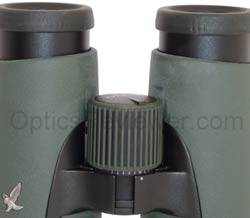
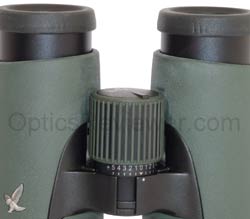
Swarovision and a Porro Prism-like Three-dimensional Effect
Of course, you already know that the Swarovski EL binoculars use the roof prism design. We were interested to notice, however, that it has a greater depth of view than many roof prism binoculars, however, to the extent that it provided more of a three-dimensional type of view than many roofs do. It's an enjoyable view and we feel that it contributes to what the person said about it being like having a close-up view without having binoculars between you and the object/activity.
What Does Swarovski Include with the EL Binoculars?
The Swarovski EL binoculars include a molded carry case which is padded with what we perceive to be similar to what is used in producing padded cases for notebook computers. We rather like the case with its two zipper pulls and a finger-pull (see picture) to open the case toward the front. The exterior is a tough nylon and the front lining is a thinner, ripstop nylon material which is also used to make pleated sides to keep anything extra in the bag from falling out when it's opened. The "compartment" for the binoculars has a soft, velour-like lining to protect the instrument from scratches. In front of that area is a smaller pocket made with small mesh and elastic at the top that seems like it was made for a lens cleaning cloth. There's also a ripstop nylon pocket against the front of the case which we feature would be ideal for a thinner local bird list or guide. Between the mesh bag area and the front pocket there appears to be enough room for a thin pair of gloves for those chilly days when we inevitably find ourselves out and about using binoculars.
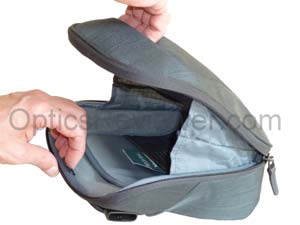
There is a neck strap provided which attaches to the lugs on the sides of the Swarovski EL binoculars and has a wide (about 1.6in/4cm), neoprene-like cushioned area to help soften the weight of the instrument on your neck. Of interest to us are the devices at the end of the cushioned component which serve to make adjusting the neck strap quick and easy. It's simply a flip of the tab, adjust the length, and flip the tab back to lock the length. We wondered if it might come loose in the field and result in a hasty grab for the binocular, but it never did.
The rain guard has provision for using the neck strap on both sides, which makes it somewhat easier to slide it on and off the oculars. The rain guard itself is made of what feels like a durable plastic with a soft touch that suggests an element of rubber in it. It has three elements: a circular cover for each ocular and a third element which serves as the hinge and covers the focus wheel. Some find that they prefer the older, softer rubber rain guards, but we didn't find that we had trouble getting acclimated to this one.
Also, in the event that you'd like to use the Swarovski Bino Suspender, which is an option for all EL models, two pieces of black nylon
webbing about 2.75in/6.5cm long and 0.5in/1cm wide with metal-reinforced eyes at both ends and a split ring already in the eyes at one
end are provided for convenience in attaching your instrument to the suspender or harness. (If you're looking for a
binoculars suspender, Swarovski (see Amazon.com)
provides them as accessories.)
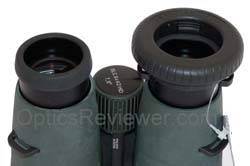
A nylon web belt is provided that attaches to the sides of the case using quick release fasteners so you can carry the case around your waist independent of the binoculars. This is a touch that goes beyond the belt loop sewn on the back of most binocular cases.
You'll find the high-quality rubber objective lens covers to be easily used in either cold or warm weather and, of course, a lens cleaning cloth is provided.
Finally, a snap shot adapter is also provided which allows the Swarovski EL binocular owner to perfectly align a digital camera with one barrel of the binocular. It's a clever device, actually, which slides over one of the eyecups and can be adjusted for the diameter of your camera's lens housing. You'll get a better understanding of it by watching the video, of course.
What's our Recommendation?
The Swarovski EL binocular with Swarovision
is presently top-of-the-line/best-in-class optics as we write this. It is our reference
binocular for its category. It provides the "wow" factor that you'd
expect in terms of bright, clear views with high resolution of detail and contrast, and super sweet spot due to the field
flattening used. When we first took a binocular with
Swarovision into the field, one of our initial sightings was a Cormorant alighting on a distant tree and we were very impressed
by how clearly we could see its webbed feet at that distance.
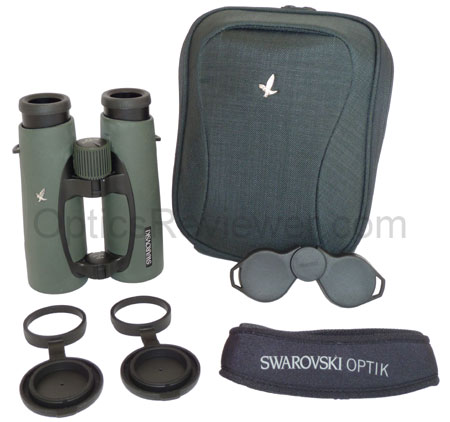
Are the Swarovski EL binoculars with Swarovision worth their price in general terms? Swarovski binoculars in general hold their value much better than most brands and this tends to take them out of the "expense" category and put them into the "investment" category for those items that provide a return over a period of time. Those who treat their binoculars well often find they can get much more of the purchase price back when selling them than with many other binoculars.
It's not unreasonable to wonder, though, when there are good quality binoculars which cost less and provide a good view. While there is an unmistakable advantage over lesser optics, is it worth paying more for that advantage? That will necessarily depend on an individual's priorities. We find that when we're choosing a binocular to use for our own pleasure and enjoyment, we invariably pick up a Swarovski binocular before heading out the door. Friends and acquaintances don't always understand that at first, until they've gone with us and had a chance to use one! The Swarovski EL with Swarovision is a keeper and we'll be keeping this one for a while.
Were we in positions where our day-to-day work involved the use of a binocular, whether as a biologist or its related fields, as an investigator, a guide, or other endeavor where our performance would be recognized by our ability to see details clearly and at times in low light conditions, we would consider these an investment in our future from which we would expect dividends. These binoculars make a difference in a person's ability to see and perform at a higher level and, of course, there's the resale value, too.
Being able to see 15-20 minutes earlier or later than others can will be significant to those making a special trip to see animals in the wild. For a growing number of folks, the Swarovski advantages are a necessity. Others see them as a reference point for what's possible to achieve in binoculars.
Swarovski has earned an enviable reputation for customer service in recent years. The official warranty for Swarovski EL binoculars' optical system is a limited lifetime warranty against defects in materials and workmanship in normal use. It's heartwarming to read the experiences people relate about the kindly generosity of Swarovski's service under warranty!
In researching the Swarovski EL binoculars with Swarovision, we found that it pays shop since the larger online dealers may have
a sale at any given time. We like to check availability and pricing through
Amazon.com (USA) and
Amazon.co.uk
.
Available configurations of Swarovski EL Binoculars with Swarovision:
| Configuration | 8X32 | 10X32 | 8.5X42 | 10X42 | 10X50 | 12X50 |
|---|---|---|---|---|---|---|
| Swarobright/ Dielectric Prism Coating | Yes | Yes | Yes | Yes | Yes | Yes |
| Field of View at 1,000 yd/m ft/m | 423/141 | 360/120 | 399/133 | 336/112 | 345/115 | 300/100 |
| Close Focus Distance ft/m | 6.2/1.9 | 6.2/1.9 | 4.9/1.5 | 4.9/1.5 | 9.2/2.8 | 9.2/2.8 |
| Exit Pupil (mm) | 4.0 | 3.20 | 4.90 | 4.20 | 5.00 | 4.20 |
| Relative Brightness | 16.0 | 10.2 | 24.0 | 18.9 | 25.0 | 18.9 |
| Eye Relief (mm) | 20.0 | 20.0 | 20.0 | 20.0 | 20.0 | 19.0 |
| Weight oz/g | 20.5/ 580 | 20.5/ 580 | 29.5/ 835 | 29.6/ 840 | 35.2/998 | 35.2/998 |
| Inter- pupillary Distance (mm) | 56-74 | 56-74 | 56-74 | 56-74 | 56-74 | 56-74 |
If you'd like to read about the Swarovski EL binoculars' sibling with at a more inexpensive price, but without field flattener lenses, we've also reviewed the SLC HD binoculars.
Home > Swarovski Binoculars > Swarovski EL Review


Your Comments
This site is for you, our readers. We appreciate your comments very much.